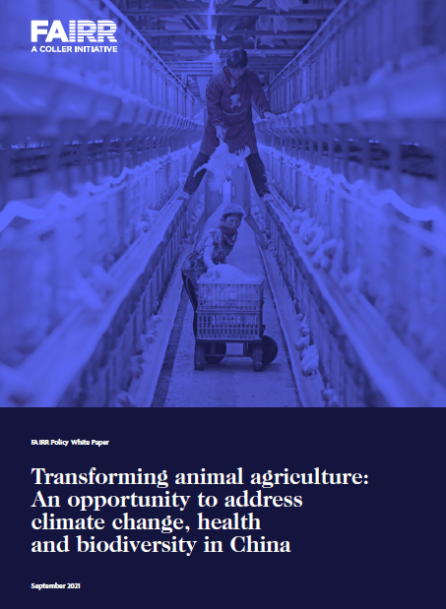Executive Summary
This paper summarises some of the key findings from FAIRR’s research on the largest Chinese protein producer companies and explores the most pertinent ESG risks and issues related to animal agriculture in China.
Of the total market capitalisation of the Coller FAIRR Protein Producer Index companies (60 in total), Chinese companies make up 40% – $136 billion out of a total of $337 billion. Of the twelve Chinese companies, ten rank as 'High Risk' across all of the assessed risk categories.
In 2020, the Chinese government set a new target to peak carbon dioxide (CO2) emissions before 2030 and reach net zero by 2060. Given that the animal agriculture sector’s contribution to China’s GHG emissions is significant across all emissions scopes, GHG emissions data disclosure by animal protein companies is necessary for effective sectoral decarbonisation planning. The paper finds that the majority of Chinese companies are ranked as ‘high risk’ when it comes to GHG emissions management, as the current disclosure is extremely limited. Crucially, none of the assessed companies in China discloses information on target setting for Scope 3 emissions, the disclosure of which is vital for understanding and mitigating climate and biodiversity impacts along the entire supply chain.
The results are similar for biodiversity risk and antibiotics use reporting. Biodiversity risk is one of the worst-performing categories, with 100% of Chinese companies ranking as ‘high risk’ when it comes to deforestation and biodiversity impacts. The continued decline in biodiversity is not just a financially material risk: it also generates significant environmental and social risks, threatening food security, destabilising livelihoods, and causing the extinction of thousands of species. Reporting on these risk categories is important for Chinese companies, and investors in these companies, to better manage material risk resulting from any adverse nature and biodiversity impacts caused by the animal protein industry, especially as China prepares to host the UN Convention on Biodiversity COP15 – the biggest global biodiversity policy summit in 10 years.
The Coller FAIRR Protein Producer Index shows that 92% of Chinese corporates included in the index do not disclose the quantity of antibiotics they use, and only 3 mention an antibiotics policy or commitment in reporting. In 2020, the Chinese State Council encouraged the livestock sector to strengthen the management of antibacterial drugs by implementing bacterial resistance monitoring and reducing the use of veterinary antibacterial drugs. Company disclosure of data on antibiotics use would enable the Chinese government to track and monitor antimicrobial resistance and disease potential and help investors identify resulting risks.
Of the twelve companies, a promising 25% report evidence of diversification into alternative protein, and current trends indicate that with private investment and government support, the market for alternative protein could grow substantially by 2030. Diversification into alternative and sustainable protein is identified as a possible strategy to simultaneously reduce multiple risks that are relevant to the Chinese policy landscape.
The China Securities Regulatory Commission recently introduced new reporting guidelines for publicly listed companies in 2021; however, these are currently voluntary and do not give detailed guidance. Improved disclosure could enhance China’s ability to reach its new climate change goals through increased data availability and better risk management while managing adverse impacts that the livestock sector has on nature and public health.
Introduction
Over the past 40 years, China has rapidly transformed into the world’s second-largest economy, achieving an average annual growth rate of over 9% between 1980–20201. This economic expansion has come at an environmental cost: China is now also the world’s largest emitter of greenhouse gases (GHG)2. Given its size, what happens in the Chinese economy and along its supply chains has repercussions for the rest of the world. Subsequently, the country plays a pivotal role in the bid to tackle global issues like climate change, biodiversity loss, and public health crises.
China’s GDP growth has led to socio-economic changes and resulted in the urbanisation of rural areas, a growing middle class and shifts in consumption patterns. Increases in disposable incomes typically result in a rise in animal meat and dairy consumption in upper-middle-income countries, as consumers spend a larger share of their food budgets on animal-sourced protein3. In 2020 alone China produced 41.3 million metric tons of pork — consuming around half the global total — and the country has fast become the largest producer of meat5. As China’s per capita meat consumption is expected to rise, the Coller FAIRR Protein Producer Index and its assessment of Chinese meat-producing companies indicates that the increasing demand for mear in China could have far-reaching impacts.
The Coller FAIRR Protein Producer Index assesses the 60 largest publicly listed animal protein producing companies in the world, scrutinising them on relevant material environmental, social and governance (ESG) issues. The methodology for the Coller FAIRR Protein Producer Index is an annual consultative process, engaging with investors, subject matter experts and companies. Companies covered by the Index are given the opportunity to respond to our analysis and provide feedback on their individual assessments. All data to which the company analyses refer is publicly available. This includes the annual and sustainability reports from the latest fiscal year and the 2019 CDP reports.
The companies assessed in the Index are some of the key suppliers to the biggest global food retailers, who are exposed to these ESG risks through their supply chains. Twelve of the largest listed animal protein producing companies are based in China, and their main protein products align with China’s top five produced protein types by quantity: pork, cow’s milk, chicken eggs, chicken, and beef6. Four of the companies’ main product is pork, four focus on dairy, with the remaining four either producing mainly beef, poultry and eggs, or a combination of protein types.
Of the twelve companies, 83% rank as 'High Risk' across the assessed categories. Only two of the companies (Mengniu and WH Group) rank as ‘Medium Risk’.
While Chinese companies make up 20% of the assessed protein producers, they actually represent 40% of the total market capitalisation in the Index: $136 billion out of a total of $337 billion. Chinese companies’ performance and disclosure behaviour across the risk categories, therefore, has significant implications for investors and policymakers both within and beyond China’s borders. This paper further explores the Chinese protein producers’ results across the Index risk categories that are most relevant to China and its policy landscape: GHG emissions, biodiversity and deforestation, antibiotic use, and sustainable protein.
As the climate and biodiversity crises rise up the global policy agenda ahead of upcoming UN COP26 and COP15 summits, China’s actions are likely to be followed closely on the global stage. The Chinese government recently announced its goal to achieve carbon neutrality by 2060, and China will host the next UN Biodiversity Summit. Increasing policy ambition in the agriculture and food sector could help China tackle biodiversity loss and accelerate its journey to net-zero, with co-benefits for other key global issues.
To continue reading, please download the full report.

